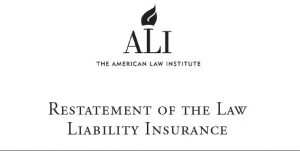 Before a court can resolve a dispute, it often needs to determine what law applies to that dispute. In certain insurance cases, that question will appear to have an easy answer. Some policies include explicit choice-of-law provisions indicating that they should be interpreted and applied according to the laws of a particular state, and such provisions are generally enforceable. But a case currently before the California Supreme Court highlights an important exception to this general rule and—should the policyholder prevail—would offer potential relief from the impact of stringent policy requirements.
Before a court can resolve a dispute, it often needs to determine what law applies to that dispute. In certain insurance cases, that question will appear to have an easy answer. Some policies include explicit choice-of-law provisions indicating that they should be interpreted and applied according to the laws of a particular state, and such provisions are generally enforceable. But a case currently before the California Supreme Court highlights an important exception to this general rule and—should the policyholder prevail—would offer potential relief from the impact of stringent policy requirements.
Ohio Court Holds Stolen Cryptocurrency Constitutes Covered Property Under Homeowner’s Policy
 A little over a month ago, a judge in Franklin County, Ohio, held that Bitcoin—a popular form of cryptocurrency—constitutes covered “property” under the terms of a traditional homeowner’s policy.
A little over a month ago, a judge in Franklin County, Ohio, held that Bitcoin—a popular form of cryptocurrency—constitutes covered “property” under the terms of a traditional homeowner’s policy.
In Kimmelman v. Wayne Insurance Group, an insured, James Kimmelman, sought coverage from his personal insurer for a loss of $16,000 in Bitcoin that was purportedly stolen from Kimmelman’s online account. Kimmelman argued that the Bitcoin constituted covered property under his homeowner’s policy. The insurer argued that Kimmelman was only entitled to recover $200 under a policy sublimit for monetary losses.
New Jersey Superior Court Issues New Rules for Complex Business Litigation
 Insurance coverage litigation can be lengthy and is usually complex, and these characteristics are only exacerbated by the need to comply with often arcane state law rules of procedure. New Jersey, long a hotbed of insurance litigation, has too often exemplified this reality. Until now.
Insurance coverage litigation can be lengthy and is usually complex, and these characteristics are only exacerbated by the need to comply with often arcane state law rules of procedure. New Jersey, long a hotbed of insurance litigation, has too often exemplified this reality. Until now.
Unjust Enrichment – How Property Insurers Use It to Deny Covered Losses
 Imagine your organization has suffered significant property damage and interruption to your business as a result. The cause could be anything—a natural disaster, severe mechanical breakdown or a cyberattack. You notify your property insurance carrier and adjust the claim, submitting calculations of your losses based on the policy’s coverages and other terms. But in response, your carrier only agrees to pay a fraction of the losses, claiming that otherwise your organization would be better off than before the damage—“unjustly enriched”—and that insurance is not meant for gain, but only to put the insured in the position it would have been without the damage.
Imagine your organization has suffered significant property damage and interruption to your business as a result. The cause could be anything—a natural disaster, severe mechanical breakdown or a cyberattack. You notify your property insurance carrier and adjust the claim, submitting calculations of your losses based on the policy’s coverages and other terms. But in response, your carrier only agrees to pay a fraction of the losses, claiming that otherwise your organization would be better off than before the damage—“unjustly enriched”—and that insurance is not meant for gain, but only to put the insured in the position it would have been without the damage.
Ohio Supreme Court Finds Subcontractor’s Faulty Workmanship Causing Damage to the Work Itself Not Covered under CGL Policy
 Last week, the Ohio Supreme Court unfortunately narrowed the scope of coverage for a subcontractor’s faulty workmanship. The court held in Ohio Northern University v. Charles Construction Services, Inc. that faulty workmanship in a construction defect case is not an “occurrence” under standard-form CGL policies in Ohio. The circumstances will sound familiar to anyone involved in the construction industry: Ohio Northern University retained Charles Construction to build a hotel and conference center on campus. The contract required Charles to maintain a CGL policy with Products-Completed Operations-Hazard coverage. Charles obtained a policy from Cincinnati Insurance Company with the required coverage.
Last week, the Ohio Supreme Court unfortunately narrowed the scope of coverage for a subcontractor’s faulty workmanship. The court held in Ohio Northern University v. Charles Construction Services, Inc. that faulty workmanship in a construction defect case is not an “occurrence” under standard-form CGL policies in Ohio. The circumstances will sound familiar to anyone involved in the construction industry: Ohio Northern University retained Charles Construction to build a hotel and conference center on campus. The contract required Charles to maintain a CGL policy with Products-Completed Operations-Hazard coverage. Charles obtained a policy from Cincinnati Insurance Company with the required coverage.
Plugging the Patent Coverage Gap
 Imagine that your company has finally released its new flagship product, which is slated to be the new lifeblood of the company. You’re elated when early sales far exceed expectations. But soon you are hit with a demand letter from a competitor alleging that the product infringes its patents, and threatening suit. Remembering that your company purchased comprehensive coverage under its commercial general liability (CGL) policy, you feel some initial relief—but soon your insurer tells you that the general policy does not provide patent coverage, or even expressly excludes such claims. Suddenly, you’re left wondering how your company will weather a costly patent lawsuit while continuing to roll out its new product.
Imagine that your company has finally released its new flagship product, which is slated to be the new lifeblood of the company. You’re elated when early sales far exceed expectations. But soon you are hit with a demand letter from a competitor alleging that the product infringes its patents, and threatening suit. Remembering that your company purchased comprehensive coverage under its commercial general liability (CGL) policy, you feel some initial relief—but soon your insurer tells you that the general policy does not provide patent coverage, or even expressly excludes such claims. Suddenly, you’re left wondering how your company will weather a costly patent lawsuit while continuing to roll out its new product.
The Times They Are A-Changin’ for Cannabis Insurance
 Like Bob Dylan, marijuana has gone from symbol of 1960s counter-culture to mainstream appeal. It is telling that Lloyd’s of London (which reportedly insures Mr. Dylan’s vocal chords) has also recently announced that that it will underwrite cannabis-related insurance in Canada, issuing policies to businesses who legally produce, distribute and sell marijuana. In the United States, an increasing number of states have legalized marijuana for medicinal and recreational uses, and others will be voting on the issue in the near future (as Michigan will this November). Federal illegality—whose days may be numbered—has become less and less of an obstacle to obtaining coverage “from seed to sale” for businesses in the legal cannabis space. This is demonstrated by two recent developments since our previous blog post on insurance for the marijuana industry.
Like Bob Dylan, marijuana has gone from symbol of 1960s counter-culture to mainstream appeal. It is telling that Lloyd’s of London (which reportedly insures Mr. Dylan’s vocal chords) has also recently announced that that it will underwrite cannabis-related insurance in Canada, issuing policies to businesses who legally produce, distribute and sell marijuana. In the United States, an increasing number of states have legalized marijuana for medicinal and recreational uses, and others will be voting on the issue in the near future (as Michigan will this November). Federal illegality—whose days may be numbered—has become less and less of an obstacle to obtaining coverage “from seed to sale” for businesses in the legal cannabis space. This is demonstrated by two recent developments since our previous blog post on insurance for the marijuana industry.
Forging New Paths: Incorporating Appellate Strategies into Insurance Litigation
 Claim analysis and pre-trial preparation can sometimes become so focused on determining what the law is that lawyers lose sight of our ability to change that law. In some cases, that means discovering and arguing new legal issues. In others, it means persuading the courts to take your side of a question that has not been decided before or has produced conflicting decisions, or even to overturn a binding ruling that stands in your way. To create these opportunities, you have to look beyond the most direct paths available—supplementing your likely trial arguments with an awareness of how the decisions you make before and at trial affect your ability to shape the law on appeal. This is as true in insurance litigation as in any other area of law.
Claim analysis and pre-trial preparation can sometimes become so focused on determining what the law is that lawyers lose sight of our ability to change that law. In some cases, that means discovering and arguing new legal issues. In others, it means persuading the courts to take your side of a question that has not been decided before or has produced conflicting decisions, or even to overturn a binding ruling that stands in your way. To create these opportunities, you have to look beyond the most direct paths available—supplementing your likely trial arguments with an awareness of how the decisions you make before and at trial affect your ability to shape the law on appeal. This is as true in insurance litigation as in any other area of law.
Electing to Pay One Claim Over Another to an Insured’s Detriment Could Subject Insurers to Bad Faith Claims
 A federal court in Michigan just breathed new life into a long-running legal saga—while at the same time issuing a warning shot across the bows of insurers—by declining to dismiss an insured’s bad faith cause of action alleging its insurer wrongly decided to pay one claim before another, to the insured’s detriment.
A federal court in Michigan just breathed new life into a long-running legal saga—while at the same time issuing a warning shot across the bows of insurers—by declining to dismiss an insured’s bad faith cause of action alleging its insurer wrongly decided to pay one claim before another, to the insured’s detriment.
The ALI’s Restatement of the Law, Liability Insurance Faces Industry and Legislative Opposition
 For nearly 100 years, the independent organization The American Law Institute has produced influential “Restatements” of U.S. common law in a wide range of areas, intended as authoritative summaries of the main currents of the law. But they’ve never tackled insurance law—until now. Restatement of the Law, Liability Insurance (RLLI), approved by the ALI in May 2018, marks several important firsts. It’s the first Restatement on insurance—a particularly complex and nuanced area of the law, as each state highly regulates it under its own sets of statutes and precedents. It’s also the first Restatement that focuses on a particular industry—insurance—as opposed to a generalized legal area such as agency, torts or property. Likely because of this, the drafting of the RLLI was not without controversy and it’s unclear how it will be received.
For nearly 100 years, the independent organization The American Law Institute has produced influential “Restatements” of U.S. common law in a wide range of areas, intended as authoritative summaries of the main currents of the law. But they’ve never tackled insurance law—until now. Restatement of the Law, Liability Insurance (RLLI), approved by the ALI in May 2018, marks several important firsts. It’s the first Restatement on insurance—a particularly complex and nuanced area of the law, as each state highly regulates it under its own sets of statutes and precedents. It’s also the first Restatement that focuses on a particular industry—insurance—as opposed to a generalized legal area such as agency, torts or property. Likely because of this, the drafting of the RLLI was not without controversy and it’s unclear how it will be received.




